EBOOK
Ecommerce Marketing: Creating Urgency
Published: Jan 18, 2018
What you’ll get from this guide
A surefire way to get results from your ecommerce marketing efforts is by creating a sense of urgency to purchase in potential customers.
Far from just a copywriting tool (“Hurry, stocks are limited!”), instilling urgency throughout the customer journey can be a powerful way to increase conversions.
With this in mind, we’ve put together this e-commerce marketing guide to show how you can make urgency tactics work for you. In it, we’ll cover:
- why we feel a sense of urgency
- top tactics for creating urgency to purchase
- best practice examples of urgency tactics in key industries
What makes us feel a sense of urgency
A useful starting point is understanding the psychology behind why urgency works so well at encouraging purchases. What’s going on in the brain exactly when this feeling is activated? The answer is FOMO.
FOMO – Fear of Missing Out – is known as a social media-fuelled sense that all your friends are having fun without you, but the psychology behind it is a deep-rooted part of the human condition.
What’s really going on in the brain when we experience FOMO? According to clinical psychologist Anita Sanz, writing at Slate:
“Our survival as an individual within a tribe, and thus our survival as a species, once hinged on our being aware of threats both to ourselves and to the larger group… To not be aware of a new food source, for example, meant you literally missed out on something that could mean the difference between life and death.”
Sanz goes on to explain that this need to be in-the-know to survive was so important that a specialized part of our brain, the amygdala (aka your ‘lizard brain’), kicks into its ‘fight-or-flight’ response when it senses that something might be going on without us knowing. This creates a sense of urgency to act, and this is where e-commerce brands can take advantage of the lizard brain’s reactions.
The sense of urgency created by FOMO is hardwired into the human brain – so whether it’s wanting to go to a party, get that last seat on a flight or book a limited-time offer, knowing that we might miss out is a powerful motivator for people to act, as emotions tend to take over the driving seat. If you can tap into this base fear and create a sense of urgency to purchase, you’ll be in a great position to influence conversions.
Ways to create urgency to purchase
Let’s take a look at some of best ways to use urgency as part of your ecommerce marketing:
Static tactics
Effective urgency tactics can be as easy as peppering your ecommerce marketing with content that points towards deadlines – this creates that FOMO feeling without having to do any extensive work. Here are some example tactics:
Sales deadlines
Simple copy communicating that a sales window is closing soon can have a big impact on purchase decisions. In the below example, Debenhams achieves this by setting out that the Blue Cross Sale ‘must end Sunday’:
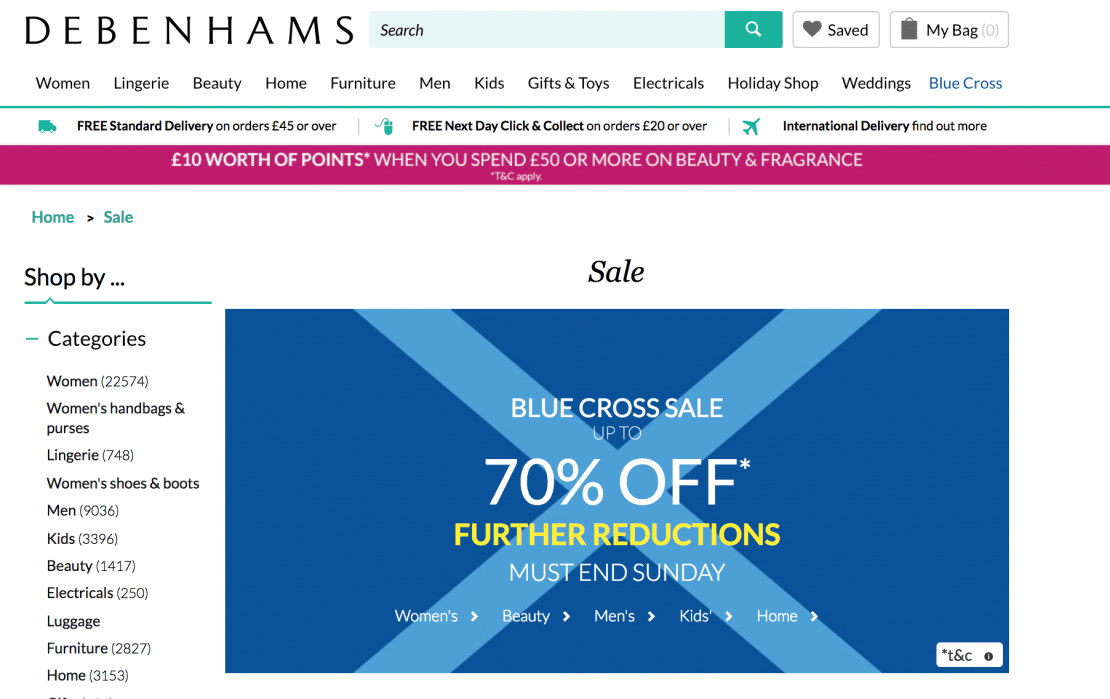
It’s a simple message that drives home the point that the customer must act now or they’ll miss out.
Basket expiry deadlines
Letting a customer know that their cart will only be saved for a short period of time can be a great tactic to instil urgency. You can see this in play on the ASOS website:
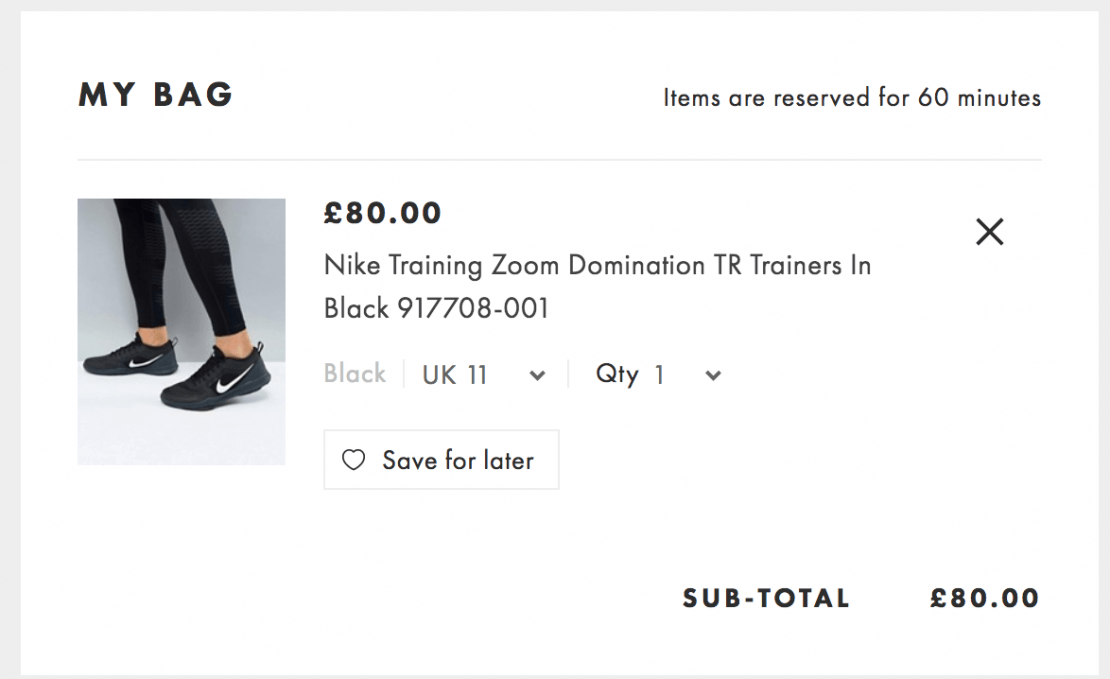
Informing customers that their items will only be in their cart for an hour can effectively encourage them to checkout in the same session.
Grey-ing out expired deals
Showing customers the promotions they’ve already missed out on can build a sense of urgency to get a deal while they still can. At Yieldify we’ve seen this kind of a message drive value for customers during Cyber Week when offers may change on a daily basis:
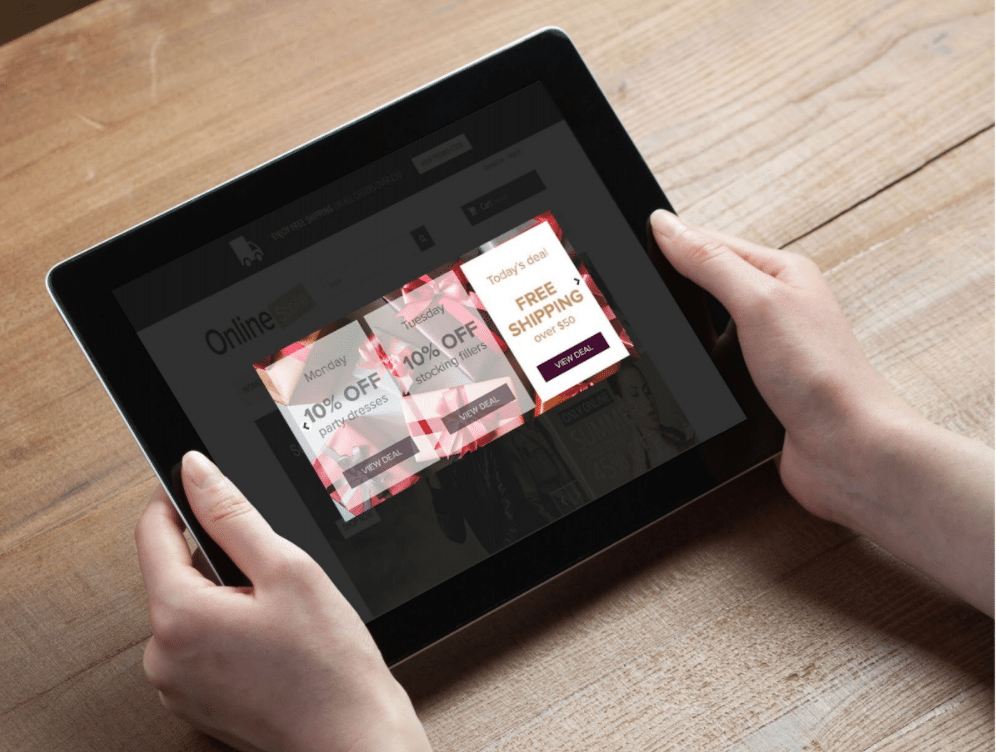
Dynamic urgency tactics
A great way to bring a sense of urgency right to the forefront of the customer journey is by showing content that changes dynamically. By making the experience more personal to an individual shopper, you can drive an ever greater sense of urgency. Here are some effective tactics:
Scarcity messages
When things are scarce, we believe they are more valuable.
In a 1975 study, researchers placed the same kind of cookie into two identical cookie jars: one of the jars had ten cookies and the other had just two. Participants consistently rated the cookies from the smaller jar as tasting better than those from the bigger jar.
This means that not only are consumers likely to feel urgency as a result of limited availability, they are also more likely to place a higher value on that item. Virgin Trains delivers effective scarcity messaging in its ticket booking funnel by showing the number of seats left available on a given journey:
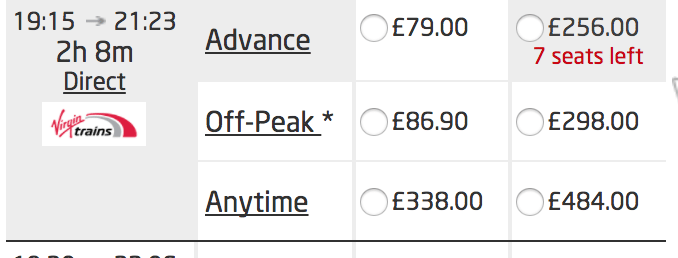
Delivery deadline reminders
You can easily inspire a sense of urgency to purchase by communicating your cut-off time for delivery by a certain date.
This is a great way to instil urgency in customers in the run-up to sales windows such as Valentine’s Day where it’s critical for a shopper to get their gifts delivered in time. Here’s an example of this tactic utilized by Debenhams where they ask ‘Want it by Friday?’:
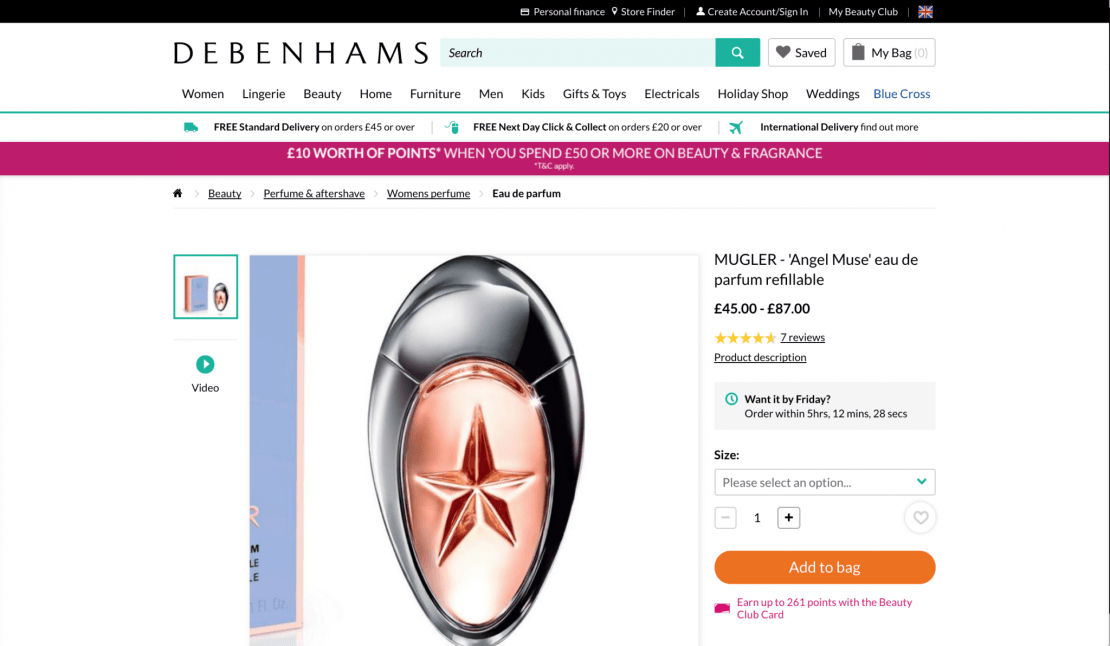
Countdown clocks
Nothing inspires urgency quite like a countdown that directs visitors to act now to avoid missing out. You can deliver this kind of urgency tactic with impact when served as a triggered interaction based on a visitors’ specific behavior while browsing the site.
At Yieldify we’ve also found that dynamic countdown clocks perform better than text-only urgency messages. Over Cyber Week, Yieldify A/B tested countdown clocks against static urgency messages and found the clocks drove a +0.71% increase in conversions. Here’s an example from ticketing website We Are FSTVL that used a countdown clock in a Yieldify campaign to drive bookings:
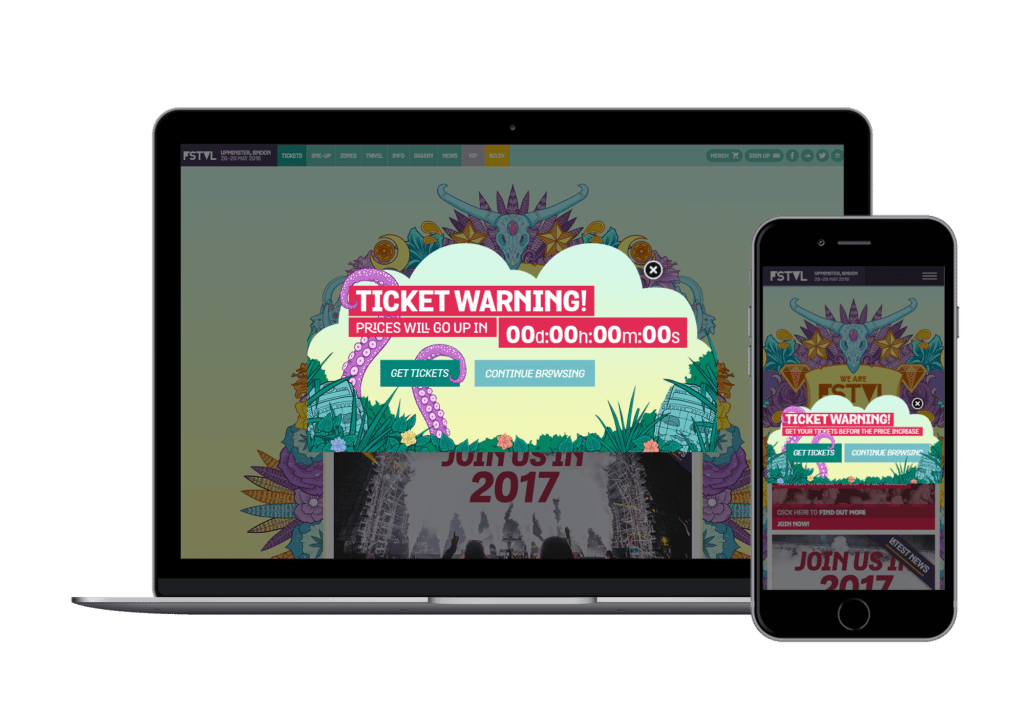
Social proof
Another powerful way to create a sense of urgency in customers is to show social proof. This is the idea that we look to what others are doing to help us in decision-making.
Messages that deliver social proof can tap into website visitor’s FOMO to drive conversions: Dynamic Social Proof from Yieldify allows you to show many others are viewing an item or have purchased it. This tactic effectively recreates a real-life sense of a group of people crowding around a product on a shelf, or staring in through a shop window. Here’s an example from footwear retailer Kickers, which achieved an 18% uplift in conversions:
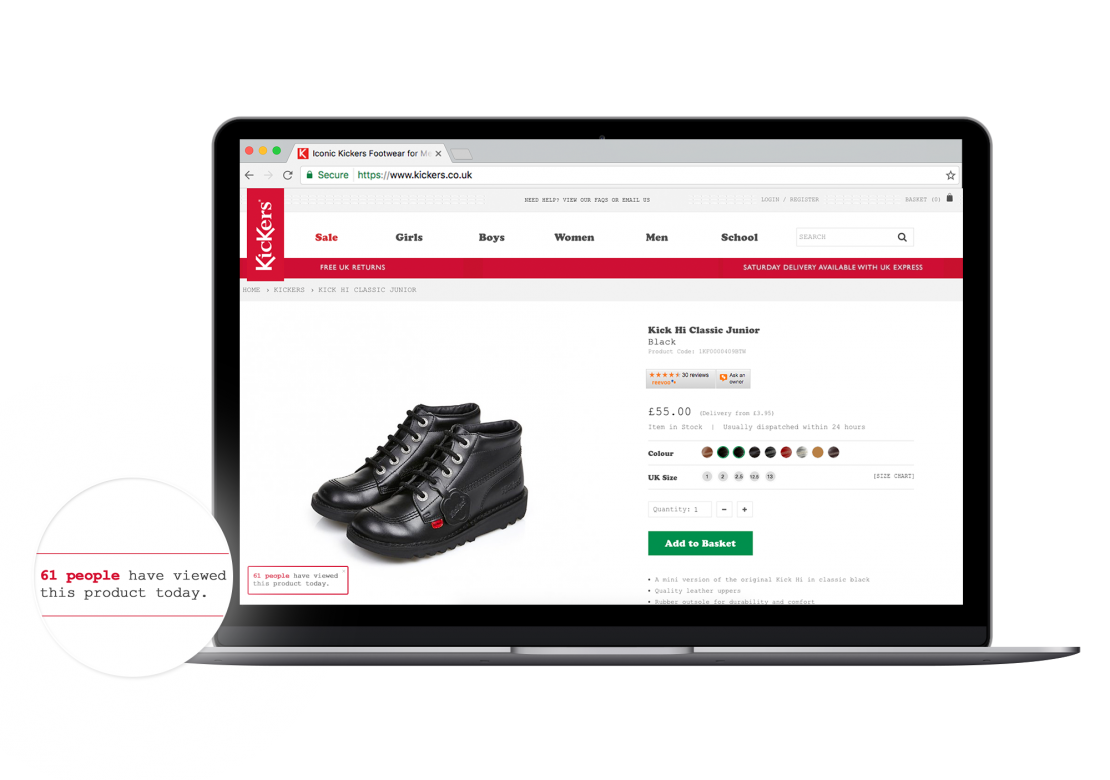
Best practice urgency tactics for your industry
Clearly, urgency tactics can play a key part in the customer journey. Delivered at the right points, they can be a compelling way to use psychology in e-commerce to optimize for conversions, nudging people towards making a sale. Let’s take a look at some vertical-specific examples of how urgency plays a part in many effective ecommerce marketing:
Retail
Urgency tactics like limited-time offers are very effective in retail sales. Take Cyber Week for example: it’s a limited time to make big savings, and consumers know that there’s a lot of competition from others to get the best deals and products. This creates a naturally-occurring FOMO – additional urgency tactics used during this time can therefore drive a huge uptick in sales.
A countdown clock is an ideal tactic to use in seasonal marketing. Furniture retailer Rum21 ran a countdown clock campaign over Cyber Week, achieving a +35.9% conversion rate uplift and +19% increase in average order value from targeted visitors:
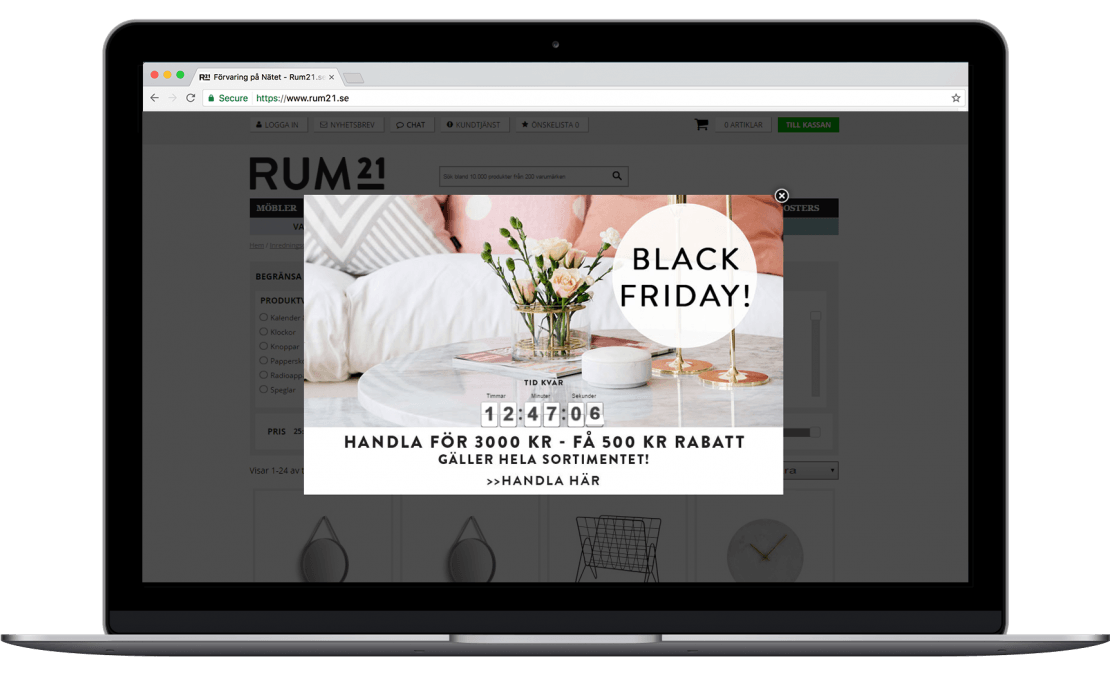
However, using urgency tactics as part of your commerce marketing strategy is not limited and can be used throughout the year. Take for example Finlayson, a Swedish homewares retailer, which promotes a weekly sale on certain lines:

With a clearly defined end-point for the sale, customers are encouraged to ‘Pick Yours’ – subtly positioning the customer to claim ownership of a popular item.
Clicking through to the product listing, we can see scarcity being invoked with ‘Only a few left’ messaging in two locations, which works in conjunction with a prominent reminder of the savings:

Travel
When consumers look to make large considered purchases such as booking flights or hotels, they’re likely to compare prices and do research across multiple sites. Travel providers must therefore work hard to keep those visitors on track to booking and persuade them not to abandon.
One of the biggest names in the travel industry, Booking.com, uses many urgency tactics across its site:

In this example of a search result, Booking.com uses urgency messaging to:
- show the scarcity of the product by showing the number of rooms left, making the call-to-action about viewing the ‘last available’ room and noting the ‘high demand’ urgency message in bold and red – well known as the colour of urgency – to attract attention.
- provide social proof by showing the number of other customers looking at the listing at the same time and its popularity by showing how many times it has been booked in the last 24 hours.
These choices are all designed to keep the visitors on site and suggest that, if they leave to compare prices, by the time they return, this valuable and desirable commodity might be gone.
In another example of an effective ecommerce marketing tactic, French holiday company Homair used Yieldify to engage website visitors to increase purchases and keep them on track to booking. When visitors were about to abandon the site, Yieldify grabbed their attention with an overlay and inspired urgency to purchase by showing how long they had left to take advantage of a ‘no booking fees’ offer with a countdown clock. By using this kind of urgency tactic, Homair saw a 144% conversion rate uplift from these targeted visitors.

Ticketing
Selling tickets online presents the perfect opportunity to use urgency tactics. For example, setting deadlines for ticket sales, underlining the scarcity of tickets available, and highlighting the fact that others will benefit from an event – even if you’re not there.
We Are FSTVL uses several dynamic and static urgency tactics on their website to encourage customers to book. For example, there’s a prominent countdown timer and scrolling marquee with deadlines above the fold of the website:

As the user clicks through to buy, a ‘limited time only’ deal takes up significant screen real estate:

Further down the page, sold-out tickets are greyed out, clearly designed to demonstrate that the longer customers wait to act, the more expensive tickets become and the greater the risk that they might sell out:

By using a range of tactics to capture the attention of visitors, We Are FSTVL subtly instils urgency throughout the customer journey in a way that both informs the customer about how long deals and offers are available and how long they have before prices increase.
In the same vertical, Ticketmaster allows customers 6.5 minutes to complete each page of its checkout process, displaying a countdown timer to ensure that users stay on-track as they progress through to the point of sale.

However, this isn’t just an arbitrary time limit: the timer is also a way to ensure fairness so other can have a chance to access tickets:

In this way, marketers can both create a sense of urgency and also communicate that this is an issue of their fairness policy, humanising the process and generating goodwill.
Conclusion
Compared with heavy-duty personalization, urgency tactics are an extremely effective way to inspire visitors to become customers. If used strategically throughout the customer journey, you can expect to see a meaningful impact on website conversions.
So, what are you waiting for? Act now to inspire urgency in your customers and avoid missing out on huge revenue opportunities.